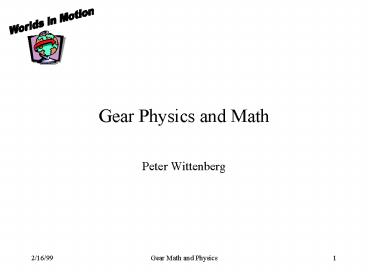Gear Physics and Math PowerPoint PPT Presentation
Title: Gear Physics and Math
1
Gear Physics and Math
- Peter Wittenberg
2
What We Will Cover
- The Key Parameters
- Force
- Torque
- Speed
- Why We Use Gears
- Gear pairs
- Compound Gears
- Compound Gear Examples
- Compound Gear Calculations
3
What You Should Know About Gears When We Finish
4
The Key Gear Physics Parameters
- Force - the push or pull (pounds)
- Except for accelerating objects, forces balance
- Torque - a version of force for rotating objects
(foot pounds) - Torque constant anywhere on a rotating shaft
- Speed - how fast something rotates (revolutions
per minute)
5
Why do we Use Gears?
- Motor - Almost Constant Speed and Power
Requirement - Jet engine - 25,000 horsepower (20 MW) _at_ 6000 to
10000 rpm - Car engine example - 100 horsepower (75 kW) _at_
3000 rpm - Human bicycling - 0.1 horsepower (75 W) _at_ 80 rpm
- Power requirements vary
- Level surface power requirement
- Uphill power requirements higher
- Gears allow a Speed / Torque Tradeoff
- no free lunch - you cant increase speed and
torque - Gearing up reduces speed and increases torque
- Gearing down increases speed and reduces torque
6
Gear pairs
- Gears Meshing on two axles
- The Gears program on the Macintosh
- Constant force - the gear teeth force must be
equal - Speed decreases and torque increases on move to
larger gear - Speed increases and torque decreases on move to
smaller gear - Gears on the same axle
- Constant torque and speed - the same shaft drives
the two gears - Force decrease on move to larger gear
- Force increase on move to smaller gear
7
Breaking Compound Gears into Gear Pairs
- All compound gears are combinations of the two
types - Two gears with meshing teeth
- Two gears on the same shaft
- Procedure
- Start at the motor - find the first two gears
- Identify the gear that takes power from that.
This is the next pair - Continue in this way until the last gear in the
chain is found.
8
Compound Gear Decomposition
75
45
15
The last 75 drives the wheels
- Gears Shafts Torque Force Speed
- Motor T F S
- 15 to 45 different 3T F S/3
- 45 to 15 same 3T 3F S/3
- 15 to 75 different 53T 3F S/3/5
- 75 to 45 same 53T 3(75/45)F S/3/5
- 45 to 75 different 53(75/45)T 3(75/45)F S/3/5
/(75/45)
9
Compound Gear Examples
10
Compound Gear Calculations
PowerShow.com is a leading presentation sharing website. It has millions of presentations already uploaded and available with 1,000s more being uploaded by its users every day. Whatever your area of interest, here you’ll be able to find and view presentations you’ll love and possibly download. And, best of all, it is completely free and easy to use.
You might even have a presentation you’d like to share with others. If so, just upload it to PowerShow.com. We’ll convert it to an HTML5 slideshow that includes all the media types you’ve already added: audio, video, music, pictures, animations and transition effects. Then you can share it with your target audience as well as PowerShow.com’s millions of monthly visitors. And, again, it’s all free.
About the Developers
PowerShow.com is brought to you by CrystalGraphics, the award-winning developer and market-leading publisher of rich-media enhancement products for presentations. Our product offerings include millions of PowerPoint templates, diagrams, animated 3D characters and more.

